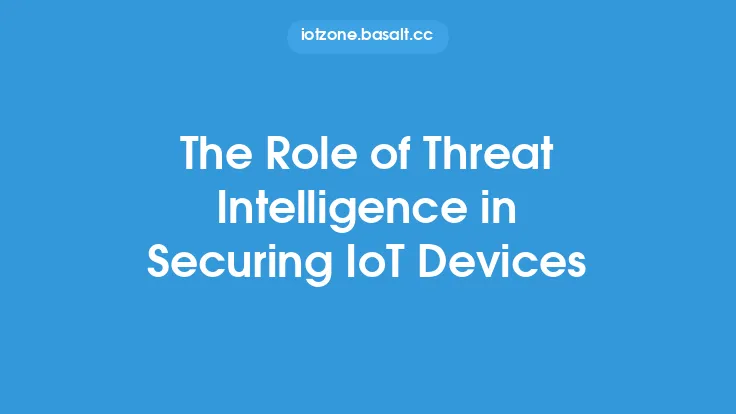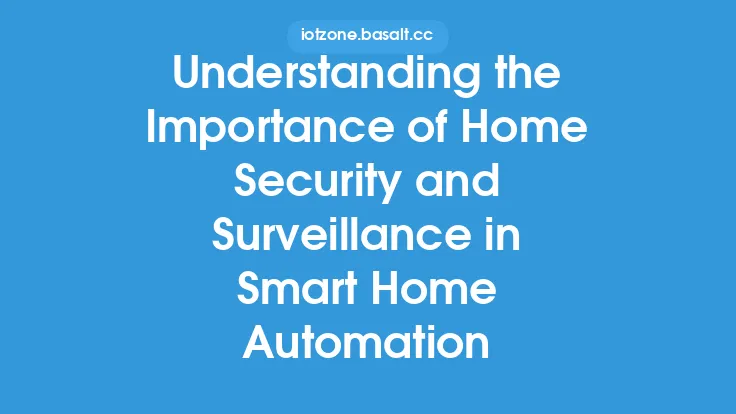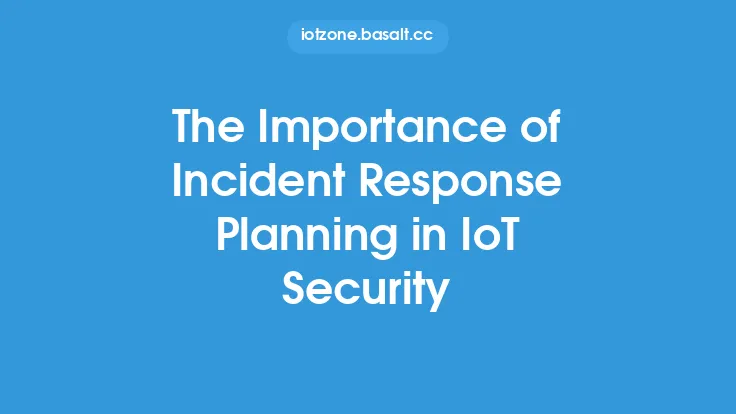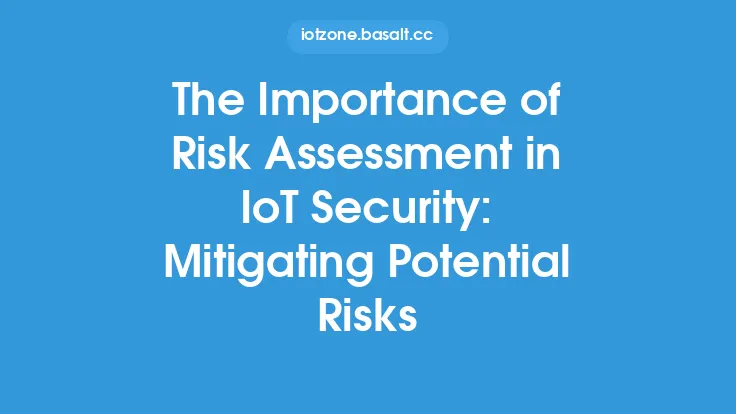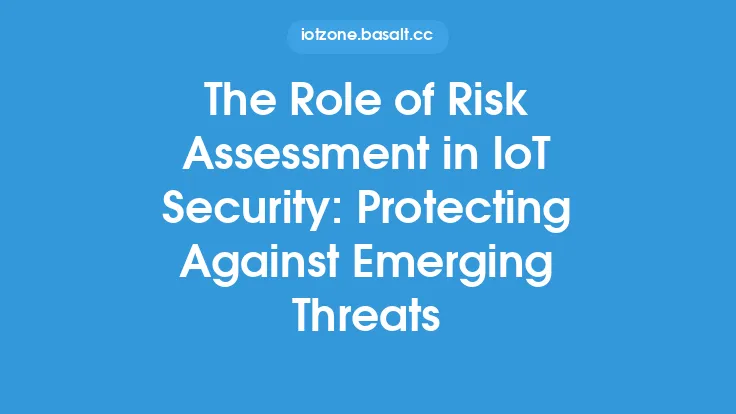The increasing number of Internet of Things (IoT) devices has created a vast attack surface, making it challenging for organizations to secure their networks and devices. As IoT devices become more pervasive, the risk of cyber attacks and data breaches also increases. To combat these threats, organizations are turning to threat intelligence as a critical component of their IoT security strategies. Threat intelligence involves collecting, analyzing, and disseminating information about potential or actual cyber threats to help organizations make informed decisions about their security posture.
What is Threat Intelligence?
Threat intelligence is the process of gathering, analyzing, and disseminating information about potential or actual cyber threats. It involves identifying, categorizing, and prioritizing threats based on their severity, likelihood, and potential impact. Threat intelligence can be used to inform various aspects of an organization's security strategy, including risk management, incident response, and vulnerability management. In the context of IoT security, threat intelligence is particularly important because IoT devices are often vulnerable to attacks due to their limited computational resources, outdated software, and lack of security features.
The Benefits of Threat Intelligence in IoT Security
Threat intelligence offers several benefits in the context of IoT security. Firstly, it helps organizations to identify potential threats before they occur, allowing them to take proactive measures to prevent attacks. Secondly, threat intelligence provides organizations with a better understanding of the threat landscape, enabling them to prioritize their security efforts and allocate resources more effectively. Thirdly, threat intelligence can help organizations to respond more quickly and effectively to security incidents, reducing the potential impact of an attack. Finally, threat intelligence can help organizations to improve their overall security posture by identifying vulnerabilities and weaknesses in their IoT devices and networks.
Types of Threat Intelligence
There are several types of threat intelligence, including strategic, tactical, and operational threat intelligence. Strategic threat intelligence focuses on high-level threats and trends, providing organizations with a broad understanding of the threat landscape. Tactical threat intelligence focuses on specific threats and vulnerabilities, providing organizations with detailed information about potential attacks. Operational threat intelligence focuses on the day-to-day operations of an organization's security team, providing them with real-time information about potential threats. In the context of IoT security, tactical and operational threat intelligence are particularly important, as they provide organizations with detailed information about specific threats and vulnerabilities.
Sources of Threat Intelligence
Threat intelligence can be gathered from a variety of sources, including open-source intelligence, commercial intelligence, and internal intelligence. Open-source intelligence involves gathering information from publicly available sources, such as social media, online forums, and news articles. Commercial intelligence involves purchasing threat intelligence feeds from specialized vendors. Internal intelligence involves gathering information from an organization's own networks and systems. In the context of IoT security, internal intelligence is particularly important, as it provides organizations with detailed information about potential threats and vulnerabilities in their own devices and networks.
Threat Intelligence Feeds
Threat intelligence feeds are a critical component of any threat intelligence program. A threat intelligence feed is a stream of data that provides organizations with real-time information about potential threats. Threat intelligence feeds can be sourced from a variety of providers, including commercial vendors, open-source providers, and internal sources. In the context of IoT security, threat intelligence feeds are particularly important, as they provide organizations with detailed information about specific threats and vulnerabilities. Threat intelligence feeds can be used to inform various aspects of an organization's security strategy, including risk management, incident response, and vulnerability management.
Implementing Threat Intelligence in IoT Security
Implementing threat intelligence in IoT security requires a structured approach. Firstly, organizations need to define their threat intelligence requirements, including the types of threats they want to detect and the sources of threat intelligence they want to use. Secondly, organizations need to gather and analyze threat intelligence, using tools such as threat intelligence platforms and security information and event management (SIEM) systems. Thirdly, organizations need to disseminate threat intelligence to relevant stakeholders, including security teams, incident response teams, and risk management teams. Finally, organizations need to continuously monitor and evaluate their threat intelligence program, ensuring that it is effective and efficient.
Challenges and Limitations
Implementing threat intelligence in IoT security is not without challenges and limitations. Firstly, the sheer volume of threat intelligence data can be overwhelming, making it difficult for organizations to analyze and disseminate the information effectively. Secondly, the quality of threat intelligence can vary, making it difficult for organizations to distinguish between accurate and inaccurate information. Thirdly, the speed of threat intelligence can be slow, making it difficult for organizations to respond quickly to emerging threats. Finally, the cost of threat intelligence can be high, making it difficult for organizations to justify the investment.
Best Practices
To get the most out of threat intelligence in IoT security, organizations should follow several best practices. Firstly, organizations should define their threat intelligence requirements clearly, including the types of threats they want to detect and the sources of threat intelligence they want to use. Secondly, organizations should use a combination of threat intelligence sources, including open-source intelligence, commercial intelligence, and internal intelligence. Thirdly, organizations should analyze and disseminate threat intelligence in real-time, using tools such as threat intelligence platforms and SIEM systems. Finally, organizations should continuously monitor and evaluate their threat intelligence program, ensuring that it is effective and efficient.
Conclusion
Threat intelligence is a critical component of any IoT security strategy. It provides organizations with a better understanding of the threat landscape, enabling them to prioritize their security efforts and allocate resources more effectively. By gathering, analyzing, and disseminating threat intelligence, organizations can identify potential threats before they occur, respond more quickly and effectively to security incidents, and improve their overall security posture. While implementing threat intelligence in IoT security is not without challenges and limitations, following best practices and using the right tools and techniques can help organizations to get the most out of their threat intelligence program.

